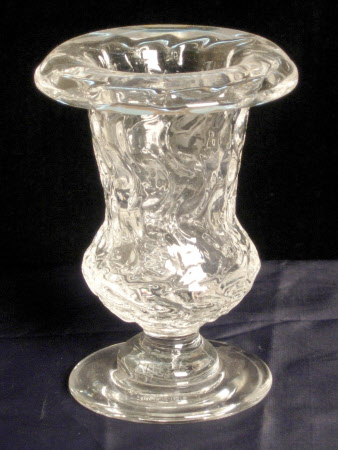Vase
Constance Spry (1886-1960)
Category
Glass
Date
1959 - 1965
Materials
Crystal
Measurements
152 mm (Height)
Place of origin
England
Order this imageCollection
Berrington Hall, Herefordshire
NT 617438
Caption
In her 1954 book How to Do the Flowers Derby-born Constance Spry wrote, ‘… with living plants as your medium, it is possible to create beauty, even to the degree of making a masterpiece’. Although she is best known for her work as a flower artist, Spry did not enter the profession until she was in her forties, having previously worked in health, social reform and education. Spry was unconventional in her practice, combining vegetables, foliage and fruit with flowers in dramatic, asymmetrical arrangements led by colour and form. She believed that it was not access to rare and expensive plants that made the best floral artist, but that it was a medium ‘for everyone who loves a beautiful thing and will take a little trouble’. Spry was equally bold in her choice of containers for flowers – advocating the use of, for example, old copper jugs, brass bowls, food tins, antique vases, silver bread baskets and old cooking pots. In the 1930s Spry and her art assistant Florence Standfast collaborated with the Fulham Pottery to design a range of simple but innovative boat-shaped vases, which complemented Spry’s open style of arrangement. Spry later collaborated with Royal Brierley to design ten vases as part of its ‘Chunky Crystal’ range, which launched in 1959. Spry had cautioned her readers against using glass vases for their arrangements, advising that ‘confused stems and stained water are an eyesore’. This was certainly borne in mind when she was designing her Brierley range: the marketing material claimed that ‘the frozen-water appearance of the Crystal obscures the confused effect liable to arise from stems in a mixed bunch’. Spry gained international recognition for her art. In 1934, amid this considerable success, she established her shop in London’s Mayfair, a suitably chic location for society’s most fashionable florist. For a time she created weekly arrangements for the Mansard Gallery in Heal’s London department store. Her most important commissions included overseeing the flower displays at Westminster Abbey for the 1947 marriage of Princess Elizabeth, and for her coronation as Queen Elizabeth II five years later. In the early 1930s Spry was in a relationship outside her marriage with the artist Gluck (born Hannah Gluckstein, 1895–1978), who painted a number of floral paintings inspired by Spry’s signature style.
Summary
A pair of crystal vases: Brierley by Constance Spry, designed ca 1959.
Makers and roles
Constance Spry (1886-1960), artist
References
Conroy, Rachel, Women Artists and Designers at the National Trust, 2025, pp. 220-223

